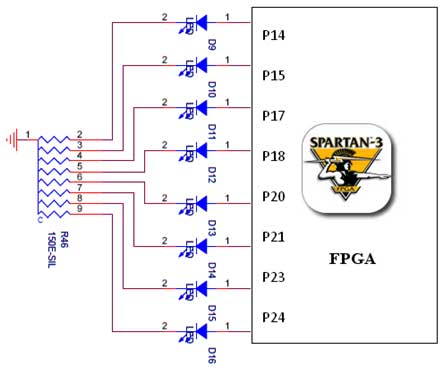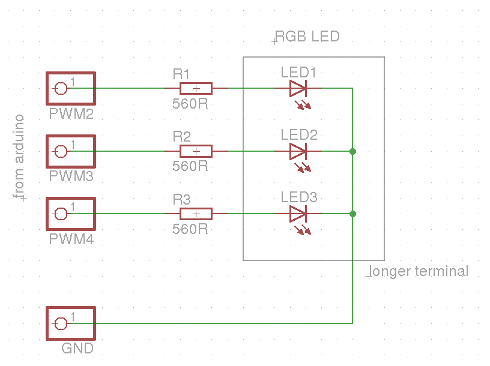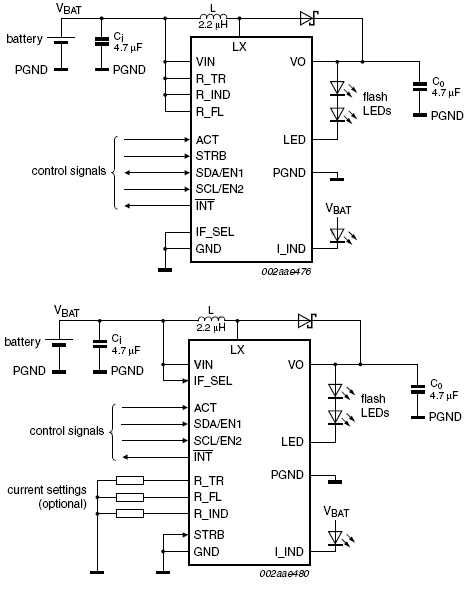
led interfacing with spartan 3 primer

The Spartan-3 board features eight LEDs connected to FPGA I/O pins, with the cathode of each LED connected to ground through a 330-ohm resistor. To illuminate a specific LED, the corresponding FPGA control signal must be driven to a high state.
The Spartan-3 board is designed to facilitate various electronic projects, utilizing a field-programmable gate array (FPGA) for flexible hardware configuration. The eight LEDs serve as visual indicators or outputs for the logic implemented within the FPGA. Each LED is connected to a dedicated I/O pin on the FPGA, allowing for individual control.
The connection configuration includes a 330-ohm resistor in series with each LED, which serves to limit the current flowing through the LED. This resistor is crucial for preventing damage to the LED due to excessive current. The cathodes of the LEDs are tied to the ground, establishing a common reference point for the circuit.
To activate a specific LED, the corresponding FPGA I/O pin must be set to a high state (logic level '1'). This action forward-biases the LED, allowing current to flow from the power supply through the LED and the resistor to ground, thus illuminating the LED. The brightness of the LED can be controlled by adjusting the duty cycle if a pulse-width modulation (PWM) technique is implemented within the FPGA logic.
In summary, the Spartan-3 board's LED configuration provides a straightforward method for visual feedback in digital designs, demonstrating the capabilities of FPGAs in controlling output devices through simple logic states. This setup is essential for prototyping and testing various electronic applications, enabling engineers to observe the results of their designs in real-time.The Spartan-3 board has eight LED Connected with FPGA I/O pins (details tabulated below). The cathode of each LED connects to ground via a 330 © resistor. To light an individual LED, drive the associated FPGA control signal to High. 🔗 External reference
The Spartan-3 board is designed to facilitate various electronic projects, utilizing a field-programmable gate array (FPGA) for flexible hardware configuration. The eight LEDs serve as visual indicators or outputs for the logic implemented within the FPGA. Each LED is connected to a dedicated I/O pin on the FPGA, allowing for individual control.
The connection configuration includes a 330-ohm resistor in series with each LED, which serves to limit the current flowing through the LED. This resistor is crucial for preventing damage to the LED due to excessive current. The cathodes of the LEDs are tied to the ground, establishing a common reference point for the circuit.
To activate a specific LED, the corresponding FPGA I/O pin must be set to a high state (logic level '1'). This action forward-biases the LED, allowing current to flow from the power supply through the LED and the resistor to ground, thus illuminating the LED. The brightness of the LED can be controlled by adjusting the duty cycle if a pulse-width modulation (PWM) technique is implemented within the FPGA logic.
In summary, the Spartan-3 board's LED configuration provides a straightforward method for visual feedback in digital designs, demonstrating the capabilities of FPGAs in controlling output devices through simple logic states. This setup is essential for prototyping and testing various electronic applications, enabling engineers to observe the results of their designs in real-time.The Spartan-3 board has eight LED Connected with FPGA I/O pins (details tabulated below). The cathode of each LED connects to ground via a 330 © resistor. To light an individual LED, drive the associated FPGA control signal to High. 🔗 External reference





